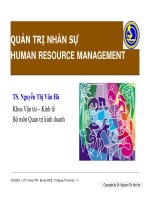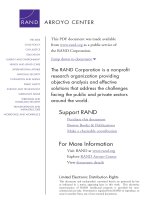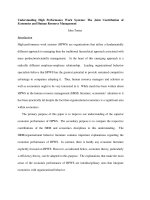HUman resource managemenr 2e s keiman chapter3
Bạn đang xem bản rút gọn của tài liệu. Xem và tải ngay bản đầy đủ của tài liệu tại đây (114.28 KB, 31 trang )
Chapter 3
Planning for Human Resources
© 2010 Cengage Learning. Atomic Dog is a trademark used herein under license. All rights reserved.
Chapter Outline
•
3-1 Gaining Competitive Advantage
•
3-2 HRM Issues and Practices
•
3-3 The Manager’s Guide
© 2010 Cengage Learning. Atomic Dog is a trademark used herein under license. All rights reserved.
3-1a Opening Case: Gaining Competitive
Advantage at General Motors
•
Problem: Time spent on completing HR transactions
hurts employee and HR productivity.
•
Solution: Developing an employee services center
website.
•
How the employee services center enhanced
competitive advantage:
Significant reduction is cost and time.
Improvement in speed and quality of employee work.
Improvement in the productivity of HR department.
© 2010 Cengage Learning. Atomic Dog is a trademark used herein under license. All rights reserved.
3-1b Linking Human Resource Planning
to Competitive Advantage
•
HR planning: Process of identifying and responding
to organizational needs and charting new policies,
systems, and programs that will assure effective
human resource management under changing
conditions.
•
Objectives of HR planning
Enable organizations to anticipate their future HRM
needs.
Identify practices that will help them meet those needs.
© 2010 Cengage Learning. Atomic Dog is a trademark used herein under license. All rights reserved.
3-1b Linking Human Resource Planning
to Competitive Advantage (cont.)
•
HR planning ties together all human resource
activities and integrates these with the rest of the
organization.
•
It enables companies to gain control of their future by
preparing for events that are likely to occur.
© 2010 Cengage Learning. Atomic Dog is a trademark used herein under license. All rights reserved.
© 2010 Cengage Learning. Atomic Dog is a trademark used herein under license. All rights reserved.
3-1b Linking Human Resource Planning
to Competitive Advantage (cont.)
•
Consequences associated with the failure to plan for
human resources
Employers are forced to respond to events after they
occur; that is, they become reactive, rather than
proactive.
An organization may be unable to correctly anticipate
an increase in its future demand for employees,
leading to understaffing.
Understaffing leads to consequences such as
increased stress levels, increase in back orders,
decrease in customer goodwill, an increase in
competition, and a loss of market share.
© 2010 Cengage Learning. Atomic Dog is a trademark used herein under license. All rights reserved.
3-2a Strategic Planning
•
Through the strategic planning process,
organizations determine where they are going.
•
The process consists of the following activities:
Determine the organizational mission.
Scan the organizational environment.
Set strategic goals.
Formulate a strategic plan, part of which addresses
human resource needs.
© 2010 Cengage Learning. Atomic Dog is a trademark used herein under license. All rights reserved.
3-2a Strategic Planning (cont.)
•
Determine the organizational mission
Mission statement is a declaration of the organization’s
overall purpose.
It defines the basic business scope and operations
that distinguish the organization from others of a
similar nature.
© 2010 Cengage Learning. Atomic Dog is a trademark used herein under license. All rights reserved.
3-2a Strategic Planning (cont.)
•
Scan the organizational environment
External and internal environments must be scanned
to identify threats and opportunities.
External environment: Includes political, legal,
economic, social, and technological issues; the
industry environment must also be scanned.
Internal environment: Assessment of the firm’s
strengths and weaknesses in order to form strategic
goals that take advantage of strengths.
The task of gathering information for strategy
formulation rests with all managers and employees.
© 2010 Cengage Learning. Atomic Dog is a trademark used herein under license. All rights reserved.
3-2a Strategic Planning (cont.)
•
Set strategic goals
Strategic goals specify the desired outcomes that must
be reached for the firm to accomplish its mission.
They should be specific, challenging, and measurable.
© 2010 Cengage Learning. Atomic Dog is a trademark used herein under license. All rights reserved.
3-2a Strategic Planning (cont.)
•
Formulate a strategic plan
Strategic plan specifies the courses of action a firm
must take in order to meet its strategic goals.
Formulated by:
-
Translating organizational goals into more narrow
functional or departmental goals.
Devising strategies for meeting these goals.
© 2010 Cengage Learning. Atomic Dog is a trademark used herein under license. All rights reserved.
3-2b Human Resource Planning
•
Through HR planning, an organization is able to
generate a list of future human resource needs and a
plan for meeting them.
•
To derive HR needs, the organization must forecast
its demand and supply.
•
Demand forecasting involves predicting the number
and types of people the organization will need at
some future point in time.
© 2010 Cengage Learning. Atomic Dog is a trademark used herein under license. All rights reserved.
3-2b Human Resource Planning
•
Supply forecasting involves estimating which
organizational positions will be filled at some future
point in time.
•
The two general approaches to demand forecasting
are – statistical and judgmental.
© 2010 Cengage Learning. Atomic Dog is a trademark used herein under license. All rights reserved.
3-2b Human Resource Planning (cont.)
•
Statistical approaches to demand forecasting
An organization predicts needed workforce size on the
basis of certain business factors.
-
A business factor is an attribute of the business such as
sales volume or market share, which closely relates to
the size of the needed workforce.
Is used when an organization operates in a stable
environment.
Most commonly used statistical methods are trend,
ratio, and regression analysis.
© 2010 Cengage Learning. Atomic Dog is a trademark used herein under license. All rights reserved.
3-2b Human Resource Planning (cont.)
•
Trend analysis: Future demand for human resources
is projected on the basis of past business trends
regarding a business factor.
•
Ratio analysis: Process of determining future HR
demand by computing an exact ratio between the
specific business factor and the number of
employees needed.
•
Regression analysis: A statistically sophisticated tool
where forecasts are based on the relationship
between a business factor and workforce size.
© 2010 Cengage Learning. Atomic Dog is a trademark used herein under license. All rights reserved.
3-2b Human Resource Planning (cont.)
•
Precaution regarding the use of statistical methods
Statistical methods of demand forecasting assume that
the relationship between workforce size and the
business factor remains constant over time.
If this relationship were to change unexpectedly, the
forecast would become inaccurate.
© 2010 Cengage Learning. Atomic Dog is a trademark used herein under license. All rights reserved.
3-2b Human Resource Planning (cont.)
•
Judgmental approaches
Involves the use of human judgment, rather than a
manipulation of numbers.
Two most common techniques:
-
Group brainstorming
Sales force estimates
© 2010 Cengage Learning. Atomic Dog is a trademark used herein under license. All rights reserved.
3-2b Human Resource Planning (cont.)
•
Supply forecasting: The process used to estimate
which positions will be filled at a particular point in
time.
•
Steps to supply forecasting
Step 1: Organization groups its positions by title,
function, and level of responsibility.
Step 2: Estimate within each job group, how many of
its current employees will:
-
Remain in their positions during the planning period.
How many will move to another position.
How many will leave the organization.
© 2010 Cengage Learning. Atomic Dog is a trademark used herein under license. All rights reserved.
3-2b Human Resource Planning (cont.)
•
Estimating future human resource needs
A firm derives its specific staffing needs by combining
the results of the supply and demand forecasts within
each job group.
© 2010 Cengage Learning. Atomic Dog is a trademark used herein under license. All rights reserved.
3-2c Outcomes of the HR Planning
Process
•
Dealing with an oversupply of employees
The current trend toward organizational restructuring
usually results in a smaller workforce.
When an organization’s strategic plan calls for
restructuring, the HRM response is usually one of
downsizing.
-
Downsizing usually means layoffs.
Because of the negative outcomes that are often
associated with layoffs, employers are encouraged to
seek alternatives.
© 2010 Cengage Learning. Atomic Dog is a trademark used herein under license. All rights reserved.
3-2c Outcomes of the HR Planning
Process (cont.)
•
Dealing with an undersupply of employees
Hiring additional workers
Alternatives to additional hiring
-
Improve productivity of existing workforce through
additional training
Overtime
Additional shifts
Job reassignments
Temporary workers
Improve retention rates
© 2010 Cengage Learning. Atomic Dog is a trademark used herein under license. All rights reserved.
3-2d Human Resource Information
Systems
•
Human Resource Information Systems (HRIS): A
computerized information package that provides
management with increasing capacity to record,
store, manipulate, and communicate information
across wide geographic boundaries, with access to
many users
© 2010 Cengage Learning. Atomic Dog is a trademark used herein under license. All rights reserved.
3-2d Human Resource Information
Systems (cont.)
•
An HRIS contains information about:
A company’s jobs
-
Number and types of jobs
Number of people needed in each job
Qualifications needed to perform each job
A company’s employees
-
Individual’s equal employment opportunity classification
Date of hire
Salary history
Performance ratings
© 2010 Cengage Learning. Atomic Dog is a trademark used herein under license. All rights reserved.
3-2d Human Resource Information
Systems (cont.)
•
Purposes served by HRIS
Handles most of the record keeping done by HR
professionals.
Reduces paperwork and cuts administrative costs.
Organizational members outside the HRM department
can more easily access the information.
Store information essential for filling vacant positions.
© 2010 Cengage Learning. Atomic Dog is a trademark used herein under license. All rights reserved.




![audio engineering 101 [electronic resource] a beginner's guide to music production](https://media.store123doc.com/images/document/14/y/ii/medium_iij1401381447.jpg)
![broken markets [electronic resource] a user's guide to the post-finance economy](https://media.store123doc.com/images/document/14/y/kz/medium_kzd1401381668.jpg)
![ios sdk programming [electronic resource] a beginner's guide](https://media.store123doc.com/images/document/14/y/ph/medium_phw1401472929.jpg)


